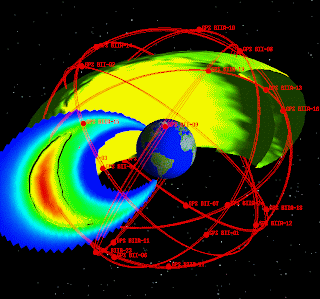 According to the recent Space News article "MDA Eyes Telecom Satellite Prime Contractor" by Peter B. de Selding, Canadian space subcontractor, MacDonald, Dettwiler and Associates Ltd. (MDA) is actively competing for contracts to produce complete commercial telecommunications satellites among central Asian nations that were once part of the ex-Soviet Union.
According to the recent Space News article "MDA Eyes Telecom Satellite Prime Contractor" by Peter B. de Selding, Canadian space subcontractor, MacDonald, Dettwiler and Associates Ltd. (MDA) is actively competing for contracts to produce complete commercial telecommunications satellites among central Asian nations that were once part of the ex-Soviet Union.According to MDA CEO Dan Friedman during an investors conference call on October 28th:
We’ve been winning pieces of communications satellites … on other people’s satellites. As we go forward, we see opportunities to sell complete satellites. We’re putting our own communications payload on it, which increases our value added and our margins.This MDA initiative follows closely on those of Ontario-based COM DEV International to inaugurate its own line of small satellites. According to ComDev CEO John Keeting, as quoted in the article "Today’s investment climate ‘sad,’ COM DEV chief says" the firm is doing as well as anytime in it's history and is investing heavily in new technology and new products even during the present tough economic times. Most recently, an American based ComDev subsidiary won a $7 million USD contract to supply space equipment to the US government.
As these two traditional pillars of the Canadian space industry grow from niche player into prime contractors, a number of newer players are developing innovative components, creating new, knowledge intensive jobs and winning contracts from government and private business all the while generally turning into profitable, skilled replacements for the roles that MDA and COM DEV are hoping to grow out of.
For example, according to the recent SpaceRef.ca article "Canadian Technologies Featured on ESA Proba-2 Mission" three smaller Canadian companies are contributing to the upcoming European Space Agency (ESA) PRoject for OnBoard Autonomy (Proba-2) satellite which contains the following Canadian components.
- New models of reaction wheels from Microsat Systems Canada Inc. (MSCI), a privately held company that was formerly the space division of Dynacon Inc.
- A fibre-sensor system for monitoring temperatures and pressures around the spacecraft, developed by MPB Communications Inc.
- New guidance and navigation computer algorithms developed by NGC Aerospace.
- Canada jumped nearly 10 percent in SCI points (a Futron developed measurement of the business climate and how investment is made in the space industry) based on government metrics around both civilian and military space policy, along with a commitment to increase overall funding on space programs.
- Canada ranks well in human capital indicators due to its strong academic network and large number of university aerospace programs and civilian research centers.
The Near Earth Report was first mentioned in my post "Canadian Space Agency Provides "No Dedicated Programs" to Support Small Aerospace Firms" which received quite a bit of comment from readers (most of which was posted under the heading "OK, So Maybe the CSA Does Provide Some Support for Small Aerospace Firms...") but no feedback or serious attempt at rebuttal from the CSA, at least so far

No comments:
Post a Comment